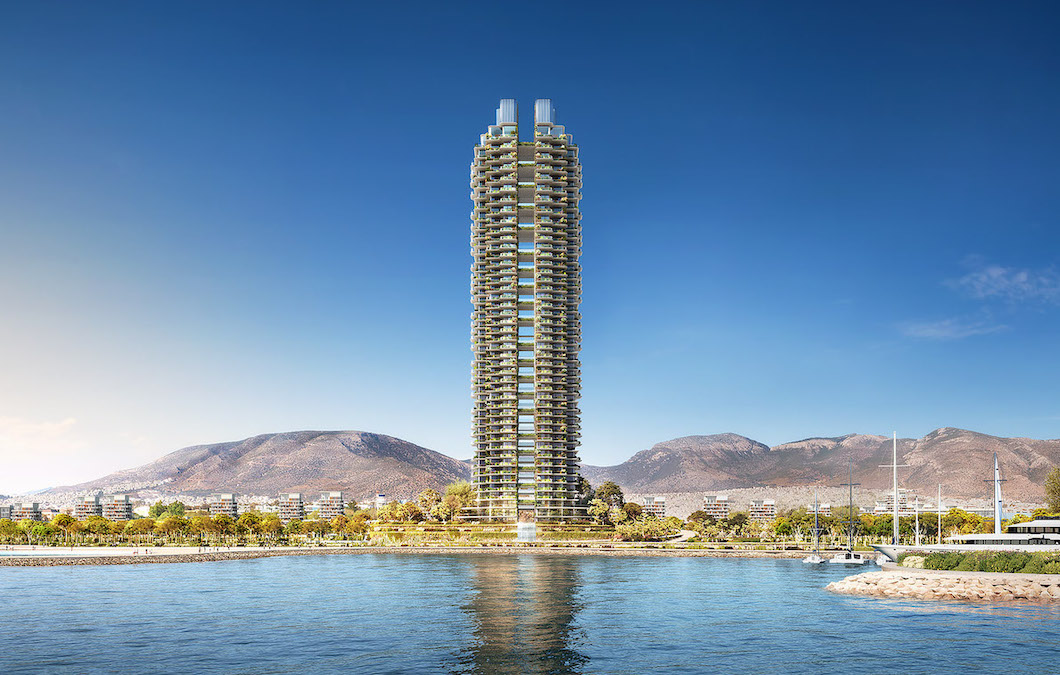The recently unveiled plans for Foster + Partners’ Marina Tower herald the greenwashed privatisation of an Athens suburb

Words by George Kafka and George Papam
As the last plane departed from Athens’ Elliniko International Airport in 2001, it began decades of uncertainty for the future of the coastal site at the city’s southern edge. Unable to serve the increasing air passenger traffic of the time and with the 2004 Olympics forthcoming, the airport had to move. It left behind an open terrain, giving rise to the vision for a large metropolitan park – a vision that was already on the table from the mid-1990s.
Through the 2000s, several other proposals for the redevelopment were formulated, with different approaches to a central idea: that if any commercial projects on the site were necessary, they should be used as funding mechanisms to support the proposed park. However, as the economic crisis took off in 2009, priorities seemed to shift. The old airport lot suddenly appeared as a valuable asset; more of an opportunity to offset part of the Greek debt than a purely public resource.
In 2014, after multiple fruitless starts, the future of the site was secured by Lamda, a Greek developer whose previous projects include large malls and a superyacht marina. Lamda completed the purchase of the 6.2 million sq m land from the state for €915m, possibly marking a new chapter in Greek urban development projects, where the notion of the private grand projét is largely an unfamiliar one.
 A defunct plane at the closed-down Elliniko airport site in 2020. Photograph: Ion Androutsopoulos
A defunct plane at the closed-down Elliniko airport site in 2020. Photograph: Ion Androutsopoulos
The Ellinikon, as the project is now known, is set to become a major new neighbourhood with flagship developments dotted around the enormous private slice of city, connected by the green spaces of a privately owned metropolitan park intended to rival Hyde Park or Central Park. Among these developments are a proposed mega-casino – widely panned for its silhouette aping the Acropolis’ ancient caryatids – as well as a shopping centre by Kengo Kuma and, the jewel in The Ellinikon’s crown, Marina Tower.
Designed by Foster + Partners, the firm also behind the site masterplan (alongside Arup, Charles Anderson Landscape Architecture and local practice Doxiadis+), Marina Tower is a residential building that was unveiled in a virtual ceremony this July. Standing at 200m tall with 200 leafy apartments across 45 floors, the tower will easily be the tallest building in Greece, and one of the ‘greenest high-rise buildings in the world’, according to the architects. Aspiring to serve as a ‘green beacon in the landscape’, it is said that the tower will be LEED and WELL certified, feature environmentally friendly materials, and have low embodied and operational energy.
The tower’s role in the broader development is at once highly generic, within the context of global development trends, and quite specific to the Elliniko context. Through its glitzy presentation, complete with soaring music and a hologram version of the building erupting up from the studio floor, the tower serves as an international advert for the development – and a successful one at that: Bloomberg recently reported the company’s claims that property prices on the site are rivalling New York, before a single marble stone has been laid.

The Marina Tower provides crucial symbolic value to the development. The architect of global stature stamps an aesthetic and infrastructural legitimacy on the project in a way that is replicated in other commercially led masterplans around the world: Heatherwick’s Vessel at Hudson’s Yard or SOM’s tower on the Belgrade waterfront, for example. A spatial product of the privateering zone par excellence, the tower constitutes the heart of what Keller Easterling has analysed as a ‘shadow state’, a camouflaging agent reaching global markets that the state could otherwise not.
Yet more than this, since its pyrotechnic premiere, the tower has become a strategic distraction from the way the project has veered from its original intentions. Its hanging gardens and green dazzle monopolised both the main public presentations of the project, as well as the subsequent media attention. What has happened to the park? It now seems less that the commercial property will serve as a funding mechanism for the maintenance of the public park, but rather that the park itself has become the multiplier of the real estate value; simply a luxury accessory for this privatised enclave of the city.
Renders from dbox/Foster + Partners
Get a curated collection of architecture and design journalism like this in your inbox by signing up to our ICON Weekly newsletter

















